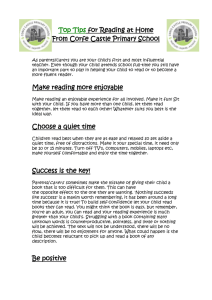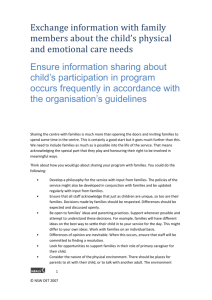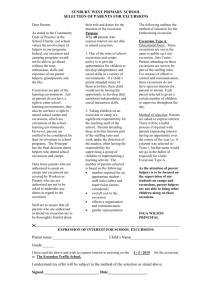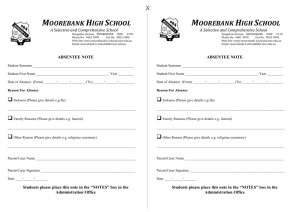Travel with children safely
advertisement
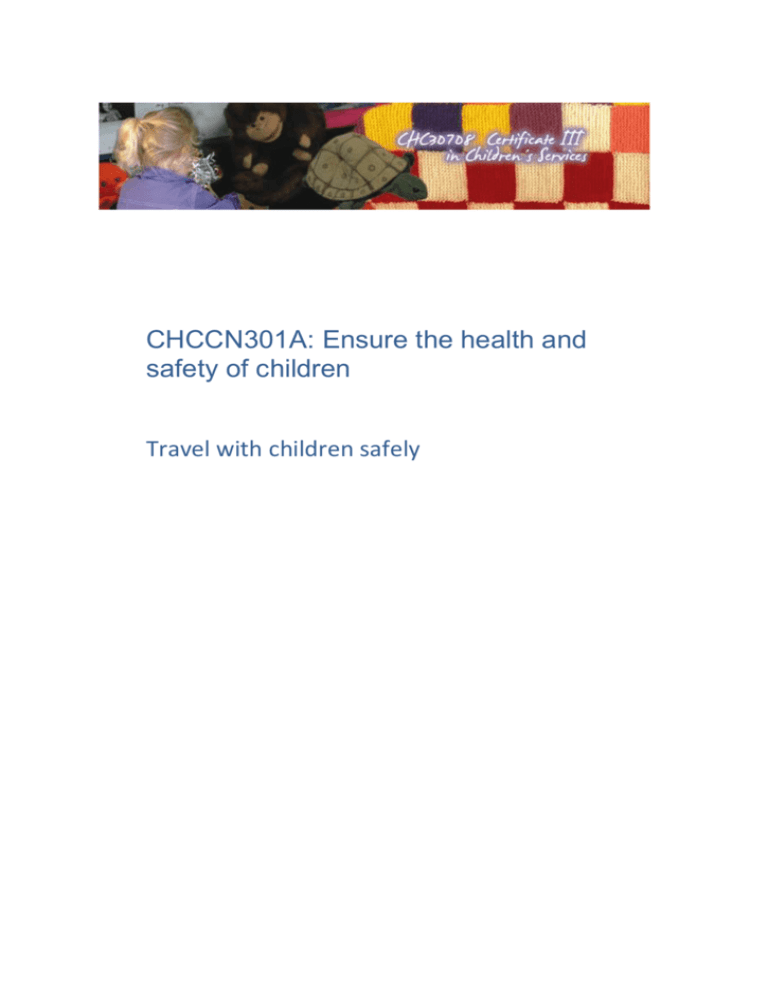
CHCCN301A: Ensure the health and safety of children Travel with children safely Contents Implement procedures for safety on excursions 3 Consent for travel document 3 Notifying parents 3 Equipment on excursions 3 Supervise children as closely as required for their ages, abilities, the contexts Appropriate child/carer ratios 6 Parent involvement 6 Monitor children’s behaviour during travel and reinforce safe, appropriate behaviour 8 Monitor children's behaviour at the destination 9 Instruct/remind children to follow relevant legal requirements 10 Children as pedestrians 10 Children as passengers 10 Children as road users 10 Identify risk situations and develop and implement strategies to minimise risk 12 Travel risks 12 Weather risks 13 Travel tips 13 Observe potential hazards and develop strategies to increase safety 2 5 14 Car travel 14 Care travel rules 15 Public transport 15 Implement set procedures to ensure all children are accounted for 17 Summary 18 Additional resources 19 Diploma of Children’s Services: CHCCN301A: Reader LO 9183 © NSW DET 2010 Implement procedures for safety on excursions Consent for travel document No child can leave the childcare premises on an excursion without appropriate, written permission from their parent or legal guardian. This includes any trip, no matter how short, which ventures outside the grounds of the service. The consent that the parent signs must be informed consent—that is, it must clearly detail the travel itinerary and it must contain the relevant legislative information. Activity 1 Notifying parents It is a good idea to send the permission slips out to the carers/parents at least two weeks prior to the outing to ensure all are returned in plenty of time. This also allows numbers for the excursion to be finalised and contingency plans put in place for those children without permission, and therefore, not permitted on the excursion. A few days before the excursion a reminder slip or notice posted to the parents detailing the outing is helpful to ensure the trip goes smoothly. It is also a timely reminder to busy or forgetful parents. It is useful to consider latecomers and include a generous departure time and a contact number for those who do arrive late. Equipment on excursions On any excursion it is necessary to include a fully stocked and in-date First Aid kit. The most you will probably require are bandaids and disinfectant but you must be prepared for all eventualities. If there are any children on the excursion with medical problems that require regular medication or children who have acute allergies that require immediate treatment, these medications must be included on the journey. Remember that you must have parent/carer permission to give any medication. Diploma of Children’s Services: CHCCN301A: Reader LO 9183 © NSW DET 2010 3 Sunscreen, tissues, mobile phone, spare hats and water are also a must on any excursion. For large excursions it may also be necessary to take a change of clothes, packed lunches and raincoats. Where children will be at a large or public venue such as a theatre, museum or aquarium, and particularly if children are not in uniform, identification badges will be required for each child. The identification badge should include the name of the service they belong to and its contact number; depending on the policy of the Centre, the child’s first name may also be included. 4 Diploma of Children’s Services: CHCCN301A: Reader LO 9183 © NSW DET 2010 Supervise children as closely as required for their ages, abilities, the contexts Why are children more at risk in traffic than adults? Think about why children and traffic are a particularly hazardous combination. Children are small, so are not easily seen by drivers. Their actions are fast and unpredictable so they are more difficult to anticipate. For example, when a car is reversing out of a driveway children are frequently below the field of vision of the driver and they do not appreciate the danger that they are in. The sound of a car starting up will not necessarily register if the child is distracted by something more interesting or is busy playing. Children are inquisitive, fearless and easily distracted. As a result they tend to take risks in the road traffic environment and are unaware of the consequences. They will run onto the road to rescue a hat that has blown off or a ball that has rolled away. Young children have not yet developed a full visual range—they have poor peripheral vision. They need to turn their whole head and body round to see from side to side. They also do not have a fully developed sense of distance perception, sound discernment and judgement skills. Children have difficulty estimating the speed and distance of oncoming cars and in judging the time they need to cross the road. Children, therefore, cannot judge traffic safely and, when a hazard arises, tend not to react effectively. A child on the kerb of a crossing will not necessarily hear or see the driver that is turning right into their pathway. All of the above factors make children and vehicles a perilous combination. Children, therefore, must never be left unattended near traffic. It is strongly suggested (by the Institute of Early Childhood Road Safety Education Program) that children should always hold an adult’s hand in traffic or when crossing a road until the age of eight. It is recommended that even children up to 10 years of age be closely and actively supervised by an adult at all times in this environment. Different developmental ages of children will require different types of supervision. The younger the child the less able they are to follow directions, see danger and to react effectively, therefore, they require physically closer supervision and constant guidance. Again holding younger children’s hands will Diploma of Children’s Services: CHCCN301A: Reader LO 9183 © NSW DET 2010 5 significantly reduce hazardous incidents when travelling. As children grow they are more able to follow directions and control their behaviour when excited. Supervision for example of kindergarten children is still is constant and careful but physically less close and more children can be supervised by one carer. Careful supervision when travelling includes: • • • • Scanning. Constant surveying of the area for potential risks and hazards. Positioning. This includes ensuring you can see well, carers staying between the children and the traffic (carers on the kerb side of the footpath) and having carers in the front and rear of the group to check for dangers. Listening. Listening for danger. This is made more difficult when travelling due to traffic noise. Knowing. Anticipating children’s behaviours and knowing what they are doing and where they are at all times. Appropriate child/carer ratios Another important way to reduce hazards when travelling with children is to ensure that there are appropriate child/carer ratios. The ratio of staff to children varies, depending upon: • • • the travel destination possible hazards such as main roads or water the developmental age of the children. It should also be remembered that the ratios set out in the regulations are minimum legal ratios. If there are significantly challenging children or a complex journey involved, then more carers will be required. If there are special needs children on an excursion the carer to child ratio must be adjusted accordingly. The travel arrangement must also take into account any special travel and mobility provisions such as disabled access or toileting facilities. Activity 2 Parent involvement Involving parents together with staff on excursions is permissible and usually very necessary to meet the legal, safety ratios. The parents must be well prepared for the event with an agenda, an itinerary, the children they are responsible for and duties required of them, clearly explained beforehand. 6 Diploma of Children’s Services: CHCCN301A: Reader LO 9183 © NSW DET 2010 Supervising children within the childcare environment, with its routines and boundaries, is a demanding activity. Just imagine how much more vigilant and organized you must be when taking children on a journey outside that environment. When you incorporate the elements of movement, excitement, noise, change of routine and other external influences, safe supervision becomes a much more challenging activity. Think for a moment, of why you would travel with a group of children. Would excursions be the only time? Travelling with children can range from a short excursion to the local park for a picnic lunch to a bus journey from the preschool to the museum. Or it can simply involve the routine collecting of children from school to walk them to after school care. During such journeys the possible dangers and hazards that children may face, are many. Activity 3 Diploma of Children’s Services: CHCCN301A: Reader LO 9183 © NSW DET 2010 7 Monitor children’s behaviour during travel and reinforce safe, appropriate behaviour There are many modes of transport the children may use, such as walking, taking a car, ferry, train, tram, or bus, to get to their destination. Travel by any method requires careful planning. Before a trip is executed, the children should be prepared for the trip. They need to have simple rules to ensure their safety. It is better to give the travel rules a few days prior to the trip and then reiterate those rules on the actual day, as children are often so excited by the adventure that they do not listen well. The age of the child will affect how the rules are given and reinforced. These rules will need to be repeated during the journey at appropriate and relevant occasions. Imagine you are taking some preschool children (3-5 years old) on a bus trip to the museum. What rules would you talk about before the journey? Before the excursion the preschool children will have the trip itinerary explained to them at an appropriate level. It is important for them to understand who is going, what they will experience and what is expected of them. The children will then get specific safety rules regarding bus travel and museum etiquette. Bus rules include: • • • • • sitting down on the bus while it is travelling no hands faces or body parts out of the bus windows no silly behaviour when getting on and off the bus listening to what the carers say standing quietly on the footpath when waiting for the bus to arrive. With each rule children require a developmentally- appropriate reason why this behaviour is required. If children understand why rules are important they are more likely to be compliant. Activity 4 8 Diploma of Children’s Services: CHCCN301A: Reader LO 9183 © NSW DET 2010 Monitor children's behaviour at the destination The preschool children will also require rules regarding their safe behaviour in the museum. Such as: • • • • Stay with your carer. Listen to your carer. Be on our best ‘excursion behaviour’. If you get lost, how to find someone to help you. If the rules and limitations are clearly set from the start the children will be less anxious, more controlled and ultimately safer. Diploma of Children’s Services: CHCCN301A: Reader LO 9183 © NSW DET 2010 9 Instruct/remind children to follow relevant legal requirements Excursions provide wonderful opportunities for carers to educate children about road safety and reinforce many legal requirements they must adhere to as pedestrians, passengers and road users. Children as pedestrians On walking excursions, children will be reminded of road safety rules, and the meaning of traffic signs and traffic lights. Crossing at lights or a pedestrian crossing reinforces road safety messages and models our responsibilities outlined in the Australian Road Rules. Children will need adult support to follow these rules. Wherever you are, on a quiet road or busy one, in a car park or on a footpath, hold each child's hand securely. Children as passengers If hiring a mini bus to transport children, we need to check that the bus has the correct child restraints. By law all children (and adults) travelling in a vehicle must wear an appropriately fitted car restraint. Messages will be reinforced clearly with the children during the excursion such as: • • • Always buckle up your seatbelt. Always leave your seatbelt buckled up in the car. Always get in and out of the 'safety door'. Alighting from the bus must be done safely - carers will remind children that ' We will wait till the bus has gone and then find a safe place to cross'. Children as road users If children ride their tricycle to the service or we provide wheeled toys for children’s use while at the service, or we hold a ‘bring your bike day’ at the centre then we need to remind children and families of the legal requirements around 10 Diploma of Children’s Services: CHCCN301A: Reader LO 9183 © NSW DET 2010 the use of wheeled toys. The Australian Road Rules state that all riders of bikes must wear an approved bicycle helmet when riding in a public space. Children are particularly vulnerable to head injuries and so helmets offer protection to the young child’s head during a falls or collision. As our duty of care requires us to protect the well being and safety of children in our care at all times reinforcing the wearing of a well fitting helmet is essential. Activity 5 From this, you might be thinking that providing a safe environment for wheeled toys in the child care service is too hard - and you wouldn’t be alone. Many services have decided that they are unable to address these issues satisfactorily and so have decided not to provide tricycles or scooters for the children’s use. Issues will need to be carefully considered by staff and families such as: Who is going to provide the helmets? If it’s the centre how will they ensure the helmets are safe for each child? How will hygiene be managed where helmets are shared by children? How can staff ensure the helmets do fit correctly? Is there time to do this thoroughly? If the families are to provide the helmets where will they be stored and how will staff know they are in good condition. Helmets that have been in an accident previously may have weaknesses that are not always clearly evident by observation alone. What happens if children don’t bring a helmet? Will this mean they won’t be able to use the tricycles, scooters because the centre doesn’t have spares? Regardless of whether wheeled toys are provided for in the service or not, you will actively reinforce key road safety messages about helmet wearing and safe places to ride bikes and tricycles with the children and families in your service. Diploma of Children’s Services: CHCCN301A: Reader LO 9183 © NSW DET 2010 11 Identify risk situations and develop and implement strategies to minimise risk Travel risks There are travel hazards associated with young, excitable children. An excursion for young children is an adventure and their behaviour is sometimes difficult to anticipate and regulate. Excursions require carers to be much more focused and diligent. Staff and children need to be prepared for travelling with the rules and the route clearly explained prior to departure. Simple measures such as careful grouping of children will reduce less desirable behaviours. Active children should be paired with less frenetic children. Pair active children with less frenetic children cli Children who require regular medication, for instance, in the case of asthma, acute allergies or diabetes will need to have their medication brought with them when travelling. The excitement of a journey and the change in routine can, on occasion, increase the chances of their medication being required. To ensure a smooth and uneventful journey a well planned and well-executed excursion with effective supervision is the answer. The route that is taken on the excursion and the mode of transport that is to be used must be well thought-out 12 Diploma of Children’s Services: CHCCN301A: Reader LO 9183 © NSW DET 2010 prior to the journey. The children should take the most direct and safest route to their destination, minimising contact with heavy traffic, road crossings, shops and heavily populated areas where possible. Activity 6 Weather risks In extreme weather conditions, travel with children should be avoided unless absolutely necessary. Heavy rain and darkened skies cause a reduction in the vision of both drivers and pedestrians, driver’s rapid braking ability decreases on wet roads, umbrellas and raincoats reduce visibility and people hurry to get out of the bad weather. All of these factors make bad weather more hazardous to travel in. In extremely hot weather the travelling risks for children include sunburn or even dehydration. Hats, sunscreen and water are a necessity on all excursions, regardless of the weather. Travel tips Here are some tips for a smooth and uneventful journey. • • • • • • • • • • Plan the route the children will take ensuring it is the safest route not necessarily the most direct. Ensure legal child to carer ratios. Hold the children’s hands. Walk on the shaded side when possible. Follow proper footpaths Cross at designated crossings, taking extra care at crossings. Be visible. Remember that children today are not always used to walking any great distance therefore, the pace and distance must be easily reached by all. Prepare the children and parents for events such as cancellation due to bad weather, or late returns. Notify the parents to apply sunscreen and to pack drinks, raincoats and comfortable shoes. Diploma of Children’s Services: CHCCN301A: Reader LO 9183 © NSW DET 2010 13 Observe potential hazards and develop strategies to increase safety Car travel Most children are used to travelling by car and will hopefully have a basic understanding of car safe behaviours. But do not assume this—not every family has a car. Children in Out of School Hours Care and children in remote areas may also be regularly transported by car or van. For example, from the Before School service to start school at 9am. Carers who transport children by car, be it their own vehicle or the service’s vehicle, need to ensure correct licensing requirements are met and parental/guardian permission ascertained in accordance with service policy. The same domestic car safe rules apply to the use of private cars transporting children to and from a service. If children from a centre or service are travelling by car, that car must be registered, roadworthy, appropriately insured and fitted with restraints suitable for the age and size of all the children travelling. All children travelling must be appropriately belted at all times, with one child per restraint. Children should never share belts with anyone. It is also extremely dangerous and illegal to sit a child on your lap and belt them with you. A child under 12 months must legally be restrained in an approved child restraint that is properly fitted and adjusted. The RTA recommends children remain in an approved child seat until the time they become physically too big for it. Child restraints, child seats and booster seats must be fitted correctly cli 14 Diploma of Children’s Services: CHCCN301A: Reader LO 9183 © NSW DET 2010 Child restraints, child seats and booster seats are weight-and size-dependant and must be fitted correctly. The RTA recommends that professionally trained fitters install restraints as even minor accidents can cause a child to have serious injuries if restraints are not installed correctly. All modes of transport used to transport children, must meet the RTA regulations and must be carefully arranged so that travelling is, where possible, done during quieter times of the day. Activity 7 RTA hotline There is an RTA hotline (Tel 1800 042 865) that will answer any further questions you may have on child restraints and their fitting. Care travel rules Here are some car safe travel rules: • • • • • • • • • • • All body parts to be kept inside the vehicle at all times. Child locks can be fitted to the rear doors for added safety A child must never travel in a seat fitted with an air bag. Children should sit in the back of the car where possible. Front seats are not illegal just less safe in the event of an accident, (and more likely to have an airbag). All children under 12 months must be in an appropriate child restraint. All passengers must wear appropriate seatbelts. Lap belts are not advisable for children. Children should exit a vehicle only on the safe side – usually the left rear door (the child lock should be engaged on the drivers side rear door) Never ever leave children unattended in the car at any time. They are in danger of playing with car controls, from car thieves and on hot days dehydration and heat stress. Ensure any objects, such as luggage or even pets, are restrained. In an accident they can become dangerous projectiles. Watch for hot seat belt buckles. Public transport When travelling by bus or train there are a few extra issues you will need to be aware of. Public transport can be extremely busy; with other travellers and there may be, delays and timetable changes to negotiate. Diploma of Children’s Services: CHCCN301A: Reader LO 9183 © NSW DET 2010 15 Following these simple safety measures will reduce some of the travel problems: • • • • • • 16 Prior to the journey view the timetables either on the web site or ring or the telephone transport line to avoid long waiting times. If catching a local bus or train, it can be useful to contact the bus company or train station beforehand to advise of your travel plans, Sometimes carriages can even be reserved for excursion purposes. Try to choose a quiet station or bus stop to wait, away from main roads. Depart from and alight at the quietest possible stations/stops. Choose a quiet time of the day to travel, between 10am and 2pm is preferable. Head count before departing, during the journey and on arriving at the destination. When out and about with young children, always hold their hands or hold them close. This is the most effective way of keeping children safe for injury. Diploma of Children’s Services: CHCCN301A: Reader LO 9183 © NSW DET 2010 Implement set procedures to ensure all children are accounted for Before the children leave the service a head count must be done and names and numbers recorded. The names of the children must tally with the list of completed consent to travel forms. No child can leave the service without parent or guardian permission. This record of names and the relevant parent/carer contact numbers must be taken with the carers on the excursion. A head count is then repeated during the excursion at significant times, such as when getting onto transport, alighting from transport, when arriving or leaving the travel destination. If there is a discrepancy in the head count, all must stop, the roll retaken and the missing child identified. If a child is lost the remaining children must wait in a safe area with their carers. If a quick search does not locate the child immediately then emergency services must be contacted. The missing child will then be searched for, the journey retraced, the child’s parents contacted and the remaining children will return home with their carers. If constant and careful supervision is practiced at all times on every journey then safety of all children is secured. Diploma of Children’s Services: CHCCN301A: Reader LO 9183 © NSW DET 2010 17 Summary • • • • • 18 Informed parental consent is required before any child is allowed to attend an excursion. Children are more at risk in the traffic environment than adults. Excursions require carers to be more focused and more diligent in their planning and supervision to reduce the traffic hazards and risks. Safety rules and limits are effective ways to guide children’s appropriate behaviour on excursions – these must be explaining both in the lead up to an excursion and during the excursion. Road safety should be integrated into the program on a daily basis. Diploma of Children’s Services: CHCCN301A: Reader LO 9183 © NSW DET 2010 Additional resources Kids and Traffic Web Site: http://www.kidsandtraffic.mq.edu.au Australian Road Rules: http://www.legislation.nsw.gov.au/viewtop/inforce/subordleg+179+2008+fn+0+N Road and Traffic Authority: http://www.rta.nsw.gov.au Diploma of Children’s Services: CHCCN301A: Reader LO 9183 © NSW DET 2010 19

